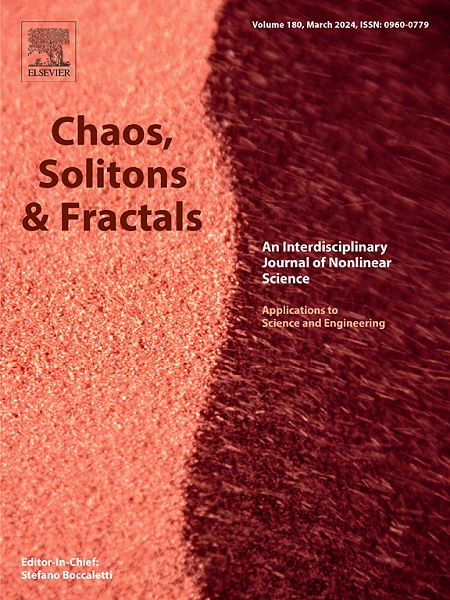Three-dimensional solitons in Rydberg-dressed Bose–Einstein condensates with spin–orbit coupling and a radially periodic potential
IF 5.3
1区 数学
Q1 MATHEMATICS, INTERDISCIPLINARY APPLICATIONS
引用次数: 0
Abstract
We propose a model of three-dimensional (3D) Rydberg-dressed spinor (two-component) Bose–Einstein condensates (BECs), with the spin–orbit coupling (SOC) and an axisymmetric radially periodic potential. It produces various species of stable 3D solitons with different vorticities in its two components. The shape and stability of the soliton are determined by the system’s control parameters: the SOC strength (), coefficients of the contact and Rydberg–Rydberg interactions ( and , respectively), and the depth () of the radial potential. The ground-state 3D solitons, with the lowest set of topological charges in its components, one of which is 0 and the other one is (these states are known as semivortices), keep the axial symmetry. Excited states with higher topological charges, which are unstable in previously studied SOC systems, feature broken axial symmetry, but may be dynamically stable states. In the absence of SOC, we also find stable two-component solitons with crescent- and hollow-shaped components.
具有自旋-轨道耦合和径向周期势的里德堡修饰玻色-爱因斯坦凝聚体中的三维孤子
提出了具有自旋-轨道耦合和轴对称径向周期势的三维(3D) Rydberg-dressed spinor(双组分)玻色-爱因斯坦凝聚体(BECs)模型。它在两个分量中产生具有不同涡度的多种稳定的三维孤子。孤子的形状和稳定性取决于系统的控制参数:SOC强度(λ)、接触系数和Rydberg-Rydberg相互作用系数(σ和Uij)以及径向势的深度(w0)。基态三维孤子保持轴对称,其分量中拓扑电荷最低,一个为0,另一个为±1(这些状态被称为半涡旋)。具有较高拓扑电荷的激发态,在先前研究的SOC系统中是不稳定的,其特征是轴对称破坏,但可能是动态稳定状态。在没有SOC的情况下,我们也发现了具有新月形和空心形分量的稳定双分量孤子。
本文章由计算机程序翻译,如有差异,请以英文原文为准。
求助全文
约1分钟内获得全文
求助全文
来源期刊

Chaos Solitons & Fractals
物理-数学跨学科应用
CiteScore
13.20
自引率
10.30%
发文量
1087
审稿时长
9 months
期刊介绍:
Chaos, Solitons & Fractals strives to establish itself as a premier journal in the interdisciplinary realm of Nonlinear Science, Non-equilibrium, and Complex Phenomena. It welcomes submissions covering a broad spectrum of topics within this field, including dynamics, non-equilibrium processes in physics, chemistry, and geophysics, complex matter and networks, mathematical models, computational biology, applications to quantum and mesoscopic phenomena, fluctuations and random processes, self-organization, and social phenomena.
 求助内容:
求助内容: 应助结果提醒方式:
应助结果提醒方式:


